Pink Syngonium, or the Arrowhead Vine, is one of the most popular houseplants in the world. This is because of their ease of care, one of their most popular features, aside from their delicate pink leaves that give you the impression of being stunning.
It takes time to perfect their care, but they are actually very low-maintenance plants once you learn what they enjoy.
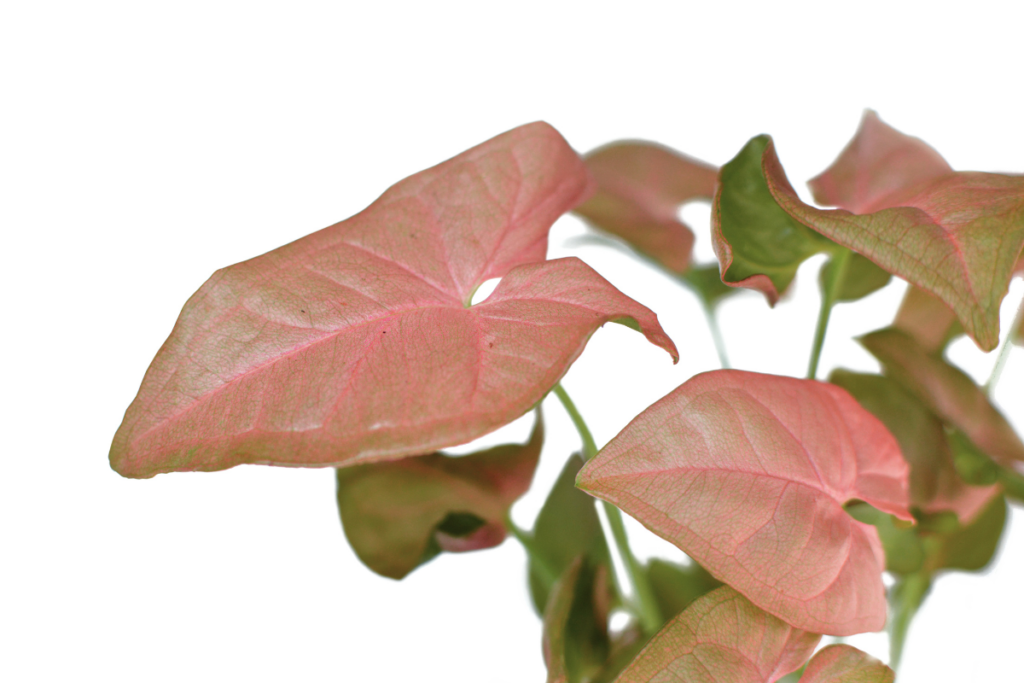
Do you want to learn more about this lovely plant? This guide will cover the basics of Pink Syngonium plant care and everything you need to know about this stunning plant.
Pink Syngonium Profile
General Information
Pink Syngonium (Syngonium podophyllum) is a stunning, rare aroid and evergreen that belongs to the Araceae family. It is a tropical plant with the potential to grow into a bushy houseplant, vine, or terrarium plant.
This houseplant is native to the West Indies, particularly Bolivia, Brazil, Mexico, Ecuador, and Mexico. Commonly, it is also known as “Arrowhead plant,” “Goosefoot plant,” and “Arrowhead vine.”
The Pink Syngonium has vibrant colors of cream and pink variegated and patterned foliage that is arrow-shaped.
This plant’s distinct shape and unique colors give you a sophisticated look in an indoor setting. These plants can grow to be 3-6 feet tall and 2 feet wide when grown indoors. Outdoors, they can grow up to 32–65 feet tall at their maximum growth.
They have a rapid rate of growth and are very simple to reproduce. It is also good to note that mature plants eventually lose the arrow-shaped foliage, becoming much broader and larger.
Etymology
The specific epithet name of Syngonium podophyllum, “podophyllum,” means stalked leaves. Syngonium derives its name from the Greek words “syn” (together or joined) and “gone” (womb), referring to its joined or united fruit ovaries.
Flowering
Despite being a flowering plant, the Pink Syngonium rarely blooms indoors. If it does, the plant’s foliage will become bushier. However, it has beautiful and patterned foliage with vibrant colors that house plant growers appreciate more than flowers.
Seasons of Interest and Purchasing
Pink Syngonium blooms from February to May and from July to September. For individuals who are new to gardening or who occasionally forget to take care of their indoor garden, the arrowhead plant is the best option because it is low-maintenance. Pink Syngonium can be purchased from local nurseries or online stores like Etsy and Amazon.
Growth
The Pink Syngonium can grow into a variety of shapes and sizes depending on where and how it is planted. It grows to a maximum height of 32–65 feet when cultivated outdoors. Indoors, it only grows to be 3-6 feet tall and 2 feet wide.
Since it is a vine, the arrowhead plant grows in an upright pattern and generally has a rapid growth rate.
Pink Syngonium Overview
| Scientific name | Syngonium podophyllum ‘Pink’ |
| Common name/s | Pink Syngonium, Arrowhead Vine, Goosefoot Plant, Pink Arrowhead Plant |
| Family | Araceae |
| Growth Habit | Herbaceous Vine |
| Height and Spread | Can grow up to 20 feet in height in the wild, and two feet in leaf length |
| Classification based on life cycle | Perennial |
| Origin and Distribution | Native to the West Indies, particularly Bolivia, Brazil, Mexico, Ecuador |
| Climate Zone | Generally warmer climate |
| USDA Plant Hardiness Zone | USDA Zone 10-12 |
| Color | Light green with pink and cream variegations |
RELATED: Monstera Peru: The Complete Care, Propagation, and Watering Guide
Care Tips
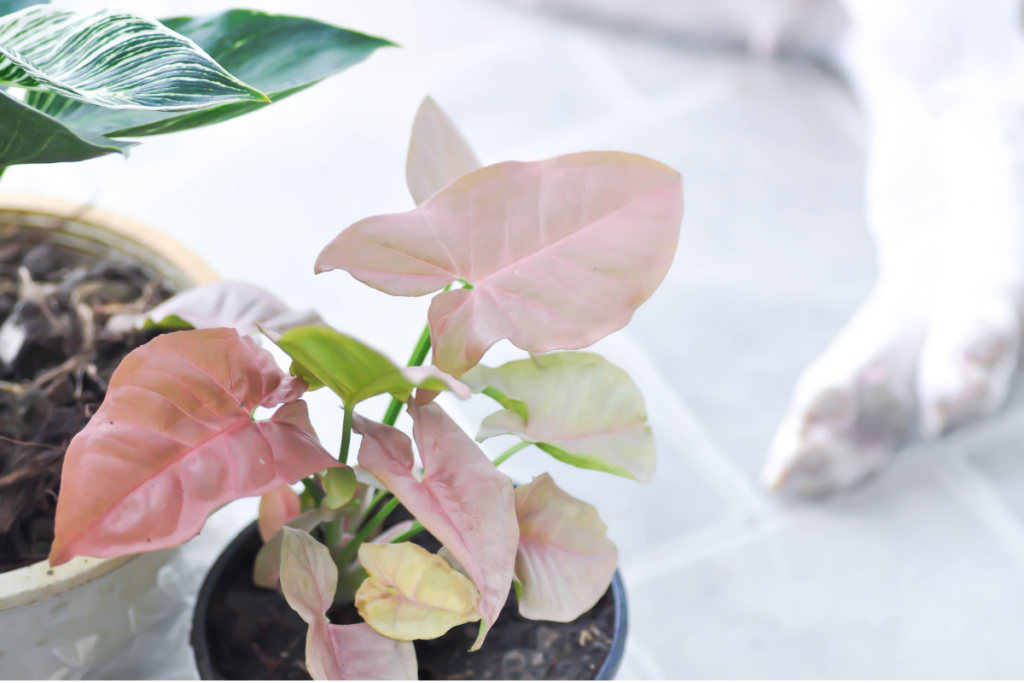
Light Requirement
Pink Syngonium thrives in medium to bright indirect sunlight. Although some houseplants can survive in very low light, it is more critical that enough light is given to this plant to produce a rich pink color on Syngonium.
With too little light, the plant will produce more chlorophyll, thereby having more green leaves than pink.
On the other hand, if you expose your indoor plant to direct sunlight, the leaves will scorch. In addition, the plant’s vibrant colors, such as yellow, pink, and green, will also fade as a result of the extreme exposure.
Temperature Requirement
To develop well and generate vibrant pink and green foliage, plants require an ideal indoor temperature of 60 °F and 85 °F (16 degrees C to 22 degrees C). Keep the arrowhead away from temperatures below 65 degrees Fahrenheit because doing so will result in stunted growth.
Furthermore, keep the plant away from direct sunlight that might lead to high temperatures. Doing so will make the houseplant droop its leaves and leave them limp.
Water Requirement
Watering Pink Syngoniums properly is one of the most important components of care. The drought tolerance of these plants is average. However, the Pink Syngonium prefers an even moisture level due to its tropical habitat, so that it will benefit from more frequent watering.
In general, young plants require less water, whereas adult plants require frequent watering. Simply ensure that the substrate has appropriate drainage and the water is correctly balanced.
Humidity Requirement
The humidity level influences the success of arrowhead vine cultivation. A moderate humidity of about 40–50% is manageable for Arrowhead Vine. This humidity level is great for cultivating different houseplants and preserving their vibrant colors and patterned foliage.
To achieve this moisture level, there are things that can be done, such as wiping the leaves, misting the leaves weekly, and using a plant saucer tray. Getting a room humidifier is also a great way to maintain an optimum level of moisture.
Soil Requirement
The best soil for growing Pink Syngonium is a light substrate mixture with medium acidity (pH range: 5.5–6.5). In addition, make sure the soil is well-drained and rich in essential nutrients.
The perfect soil blend for Pink Syngoniums includes good drainage, water retention, and aeration properties. A mixture with perlite helps you achieve these characteristics.
Fertilizer Requirement
The Pink Syngonium plant benefits greatly from slowly-releasing houseplant fertilizer. However, it is best to dilute the fertilizer and apply it monthly.
A balanced feeding should be done once a month. However, it would be best if you fertilized the Syngonium every two weeks during the growing period, which is usually during spring and summer.
Space Requirement
You don’t need much room to grow Pink Syngonium. Only a small amount of room is required for these small vines. Despite the fact that it can be grown in soil or pots, it is best planted in decorative containers like terrariums or vivariums.
RELATED: Peperomia Polybotrya: The Number 1 Care, Watering, and Propagation Guide
Growing And Planting Tips
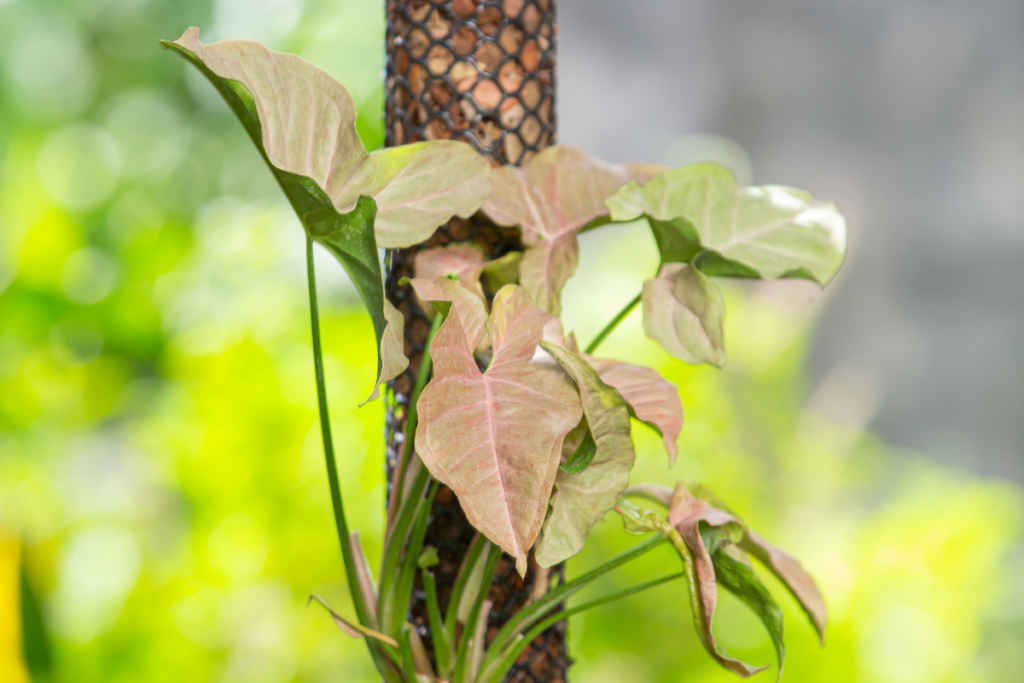
Propagation
The Pink Syngoniums can be propagated mainly in two ways: (1) propagation by shoot-cuttings and (2) water reproduction. These methods have their own specific pros and cons, but both prove to be effective in propagating these plants.
Propagation By Shoot-Cuttings
The simplest way to propagate a Pink Syngonium is to cut the stems from a mother plant. This can be done by putting the shoot in a rooting medium.
Once the roots are established, the cutting can be treated as a separate plant and can grow in the desired place. Simply take a 5 to 7-inch stem-tip cut. Remove a few leaves from the bottom.
Plant the cutting in a moist, easily prepared substrate. To allow root development, ensure at least three nodes are under the soil.
Propagation Of Water
Water propagation can also be used to propagate Pink Syngonium. Just dip the shoot-cuttings in a container with water. Make sure 2-3 nodes are present under the water. Roots development will start in about 3 to 4 weeks. After the root development, you can transfer the cuttings to the soil.
Pruning
For the Pink Syngonium plant, proper pruning is very important. Pruning regularly will help control the overgrown vine and give the plant a bushier appearance. Cut off the new stem growth that is forming around the nodes to encourage new growth where the cut was made.
In the spring, it is advisable to consider pruning and trimming. Plant growth is at its strongest during this time. Avoid pruning in the early or late fall when new growth has stopped.
Potting And Repotting
Given that Pink Syngonium is an aggressive, quick-growing vine, how often you repot it will depend mostly on how big you want it to become. This plant is prone to root-bound situations, so to ensure its success, think about repotting it once a year or every two years in the early spring.
To grow a larger vine, repot annually. Otherwise, to prevent the plant from becoming root-bound, replace the potting medium every spring and repot every other year.
Pink Syngonium Care
| Light | Medium to Bright indirect light |
| Temperature | Intermediate to warm, 60-85 degrees Fahrenheit |
| Water | Once a week, increased in summer, decreased in winter |
| Soil | Well-draining, organic rich, moist soil |
| Fertilization | Regular household fertilizer, once a month |
| Space | Climbing space |
| Propagation | Via stem propagation and water propagation |
| Blooming | Rarely blooms, enough sunlight and maturity needed |
| Pruning | Regular pruning |
| Potting | Regular potting mix, use of perlite recommended |
Problems And Troubleshooting
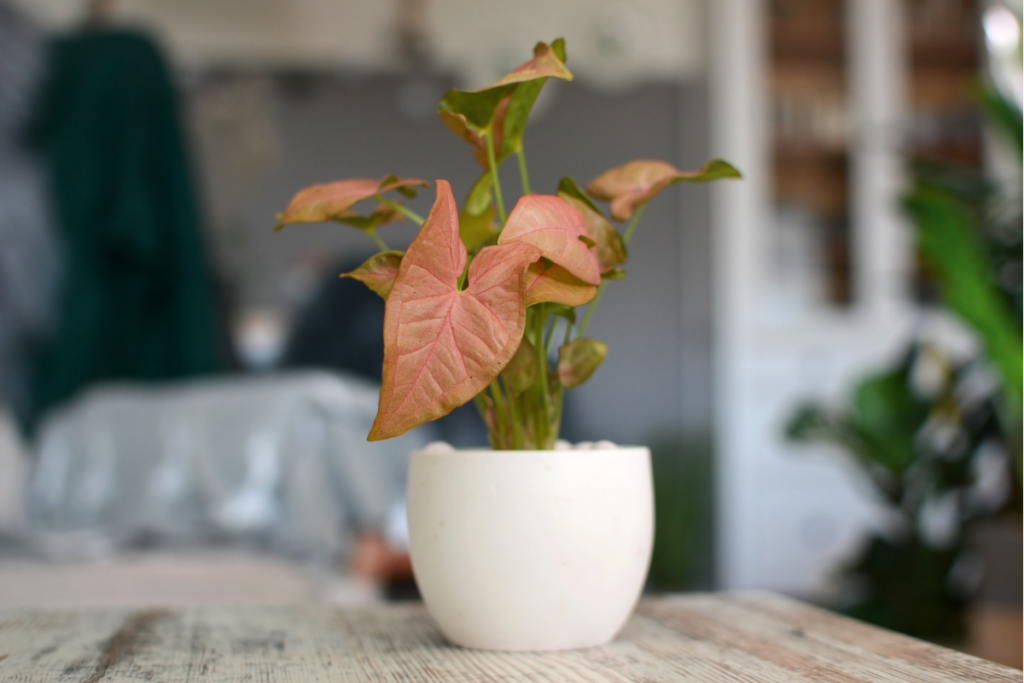
Overwatering
The amount of oxygen that roots need to thrive can be severely reduced by overwatering a plant. Root rot, sogginess, and irreversible root decay can all result from excessive water use.
The most likely cause of yellowing arrowhead leaves is overwatering, which tends to result in inadequate soil moisture or moisture stress.
This prevents the plant from receiving enough oxygen and nutrients to produce chlorophyll. Your plant won’t produce the pigments that give its leaves color if it doesn’t have enough chlorophyll.
Underwatering
Supplying the arrowhead plant with a little water makes the plant dry out, and the leaves turn brown. More so, exposing the plant to direct light without proper watering causes scorching. This is the reason behind the browning of the foliage.
To preserve the plant, growers may recommend watering the plant as per the proper scheduling and keeping the plant in indirect sunlight.
Nutrient Deficiency
Fertilizing plants can compensate for any nitrogen or phosphorus deficiencies. For example, yellowing of older leaves is a common sign of nitrogen deficiency, whereas phosphorus deficiency is the primary cause of dead patches on lower leaves and stunted development.
The plant will receive the necessary nutritional boost for its vibrant green and pink leaves by being fed with complete and balanced fertilizer.
Flowering Problem
The Arrowhead plant is known for its arrow-shaped or goosefoot-shaped leaves and bushy foliage, but not flowers.
The plant may give off flowers in its natural habitat, but not so much when grown indoors. When a mature plant blooms, consider pruning the buds to make way for bushier foliage.
Regular pruning during spring will help keep the plant small and avoid getting bushy. Please avoid using the blossoms or flower buds from Syngonium for decorations, as they are equally toxic. Flowers used for decorations are more likely to be accidentally consumed.
RELATED: Tradescantia Nanouk: The Care, Propagation, and Watering Guide You Need
Pink Syngonium Pests And Diseases
| Common Pests/Diseases | Symptoms | Treatment and Prevention |
Common diseases include stem rot, crown rot, root rot, fungal diseases, leaf spot, and Xanthomonas infection | Yellow rims around dark brown or black spots on leaves | Do not overwater. Keep the soil dry. Avoid extreme humidity.Proper ventilation is needed around the plant. Remove infected parts of fungal infections to avoid spreading. |
Common pests include mealybugs, spider mites, aphids, and scales | Visible insects on the surface | Spray plant with warm, soapy water. If infestation is present, use insecticide or neem oil. Use diatomaceous earth. |
Problems With People And Animals
Toxicity
Arrowhead plants are extremely toxic. Therefore, kids or dogs should not touch any part of the plant because doing so can have negative effects.
The plant’s toxicity comes from the calcium oxalate substances that cause gastrointestinal distress, oral swelling, and drooling in cats. Like its distant relative, Philodendrons, Syngonium produces poisonous leaves, stems, and blossoms that can quickly make you sick if consumed.
Syngonium Meaning And Symbolism
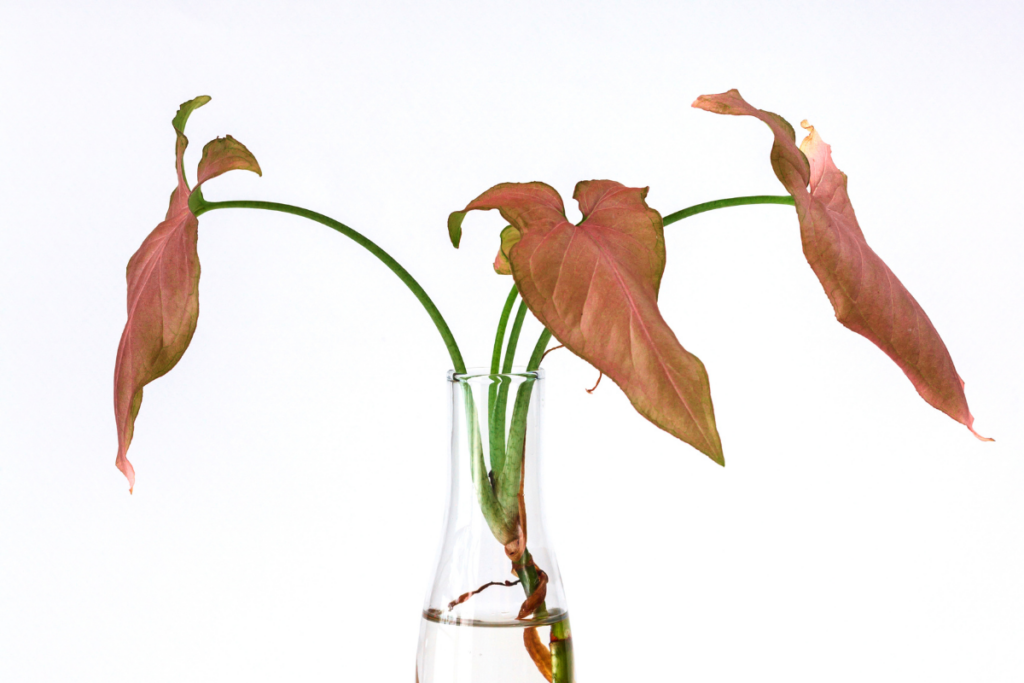
The five-lobed shape of Pink Syngonium leaves symbolizes the five Feng Shui elements: wood, metal, earth, fire, and water. As a result, it encourages positive chi or energy and perfectly balances Yin and Yang energy.
| General Meaning | Five Feng Shui elements: Wood, Metal, Earth Fire, and Water |
| Symbolism | Positive Chi, Balanced Yin and Yang energy |
Landscaping And Gardening Ideas
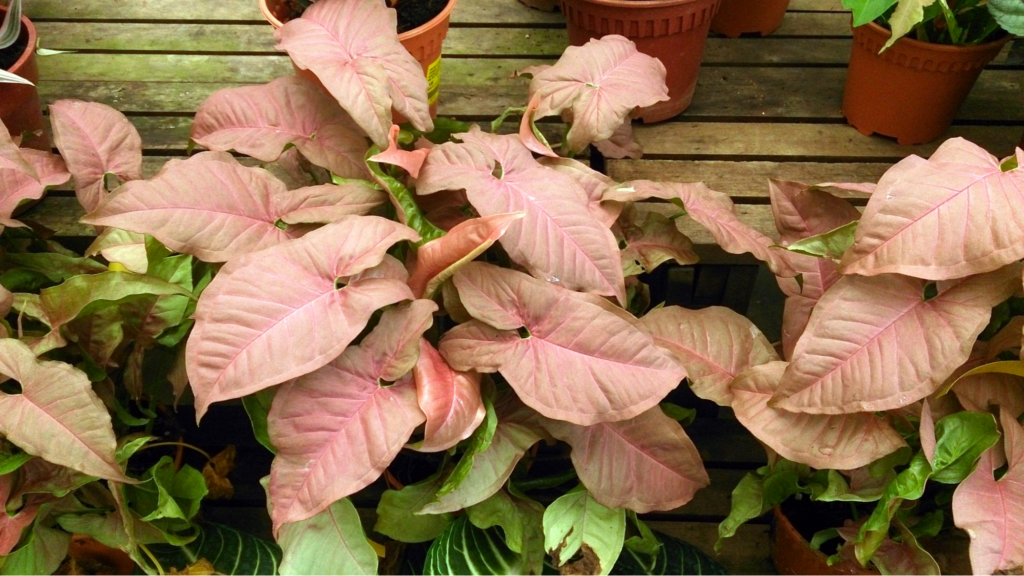
Companion Plants
Dieffenbachia and ficus are good companion plants for Syngonium. If you want a more tiny plant, compact Syngonium cultivars such as Pink Allusion’ and Julia Allusion’ are excellent possibilities.
Both plants have light green foliage. ‘Julia Allusion’ has coppery pink flushes that contrast with the dark green borders and pinkish veins of ‘Pink Allusion.’
Other Syngonium varieties that are good companion plants include Syngonium Neon Robusta, Pink Splash, and Syngonium Pink Perfection.
Landscaping Ideas
Syngonium is a fast-growing, trailing plant with attractive leaves that works well in tiny containers and on trellises. It is great for indoor design because of its appealing coarse-textured foliage with beautiful leaves and patterns.
This gorgeous plant may be planted in attractive containers on windowsills in living rooms, bedrooms, and hallways.
| What to plant with | Dieffenbachia, Ficus, Other Syngonium Plants |
| What NOT to plant with | Basically nothing |
Conclusion
Growers can definitely consider the Arrowhead Plant if they’re looking for a low-maintenance houseplant. The Pink Syngonium has lush, pink leaves that are to die for.
With proper care and love, your favorite tropical plant will surely become a vital ingredient in your home’s interior decor.
Frequently Asked Questions
How do you keep Pink Syngonium pink?
To maintain the pinkiness of your plant, maintain the optimum light, humidity, and temperature. Always avoid direct sunlight, which will make your leaves brown and eventually burn. Low light, on the other hand, makes your plant more green.
Is Pink Syngonium rare?
Yes, the gorgeous pink aroid is a rare plant. However, the Pink Syngonium, with its vibrant pink and cream variegations, is a must-have for any plant collector. The varieties are variable, so each new foliage is definitely a surprise!
Why are my Pink Syngonium leaves curling?
Curling Pink Syngonium levels are usually due to low humidity or underwatering. However, extreme light also causes curling of leaves, thus ensuring your plant is in bright indirect light.
If this is a watering problem, ensure to water your plants on time properly. However, as a general rule, only water your plants when the top soil is dry. Check the soil moisture by sticking a ruler or your finger on the top 2-3 inches of soil. If it’s dry, water your plant. If it is still moist, wait it out to ensure your plant from overwatering.
Is Pink Syngonium an indoor plant?
Yes, your Pink Syngonium can be grown indoors as it can tolerate the environmental conditions inside your home. Although their growth is limited indoors, they can still thrive like how they can when they are outdoors. Just ensure optimum light, temperature, humidity, and watering.
Is Pink Syngonium toxic?
Like your other Aroid plants, such as Philodendrons and Monsteras, your Syngonium plants are toxic because of the calcium oxalate crystals. Always keep these plants away from your pets and small children to avoid further complications.
Editor’s Recommendations
Philodendron gloriosum: The Fail-proof Care, Propagation, and Watering Guide You Need
Philodendron rugosum: The Care, Propagation, and Watering Guide You Need







